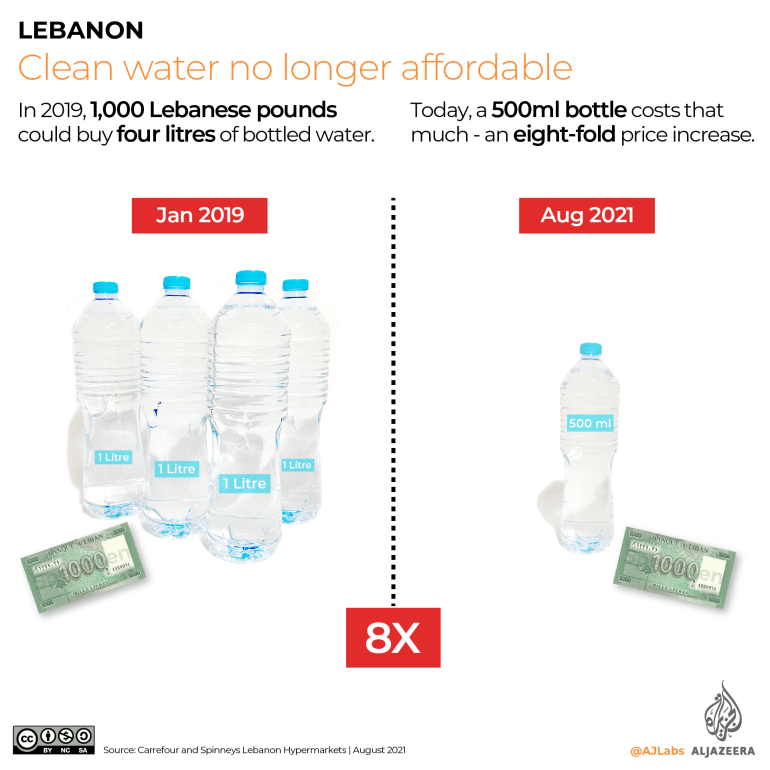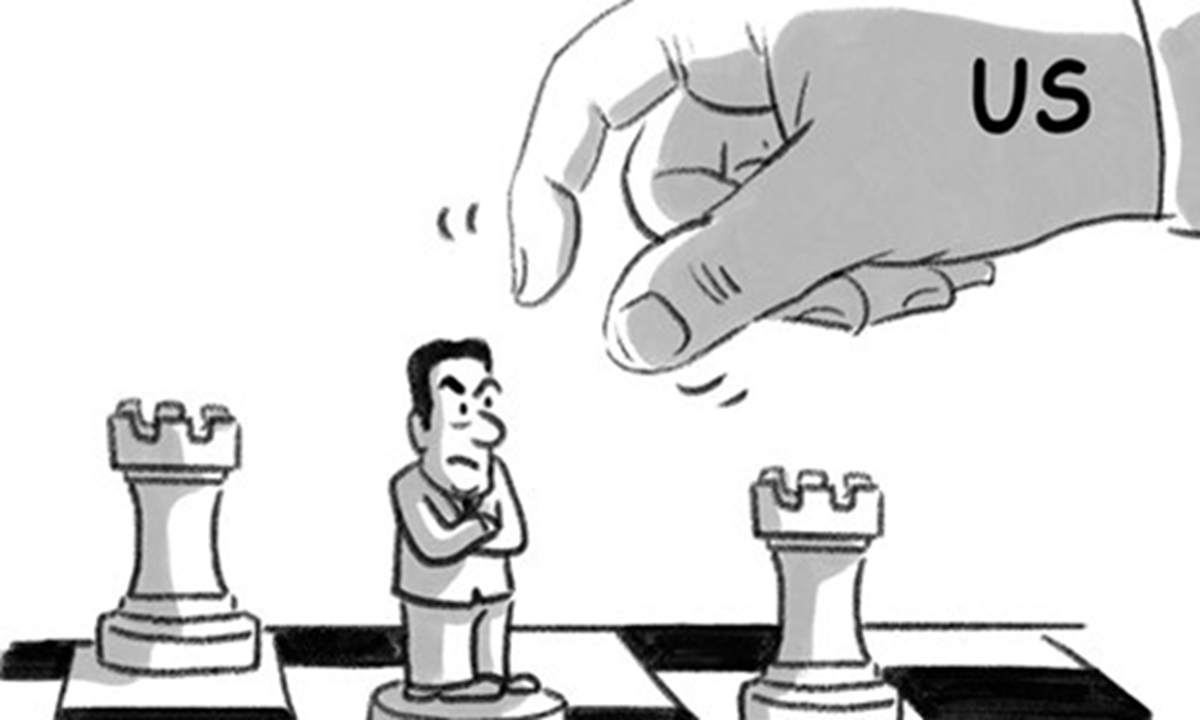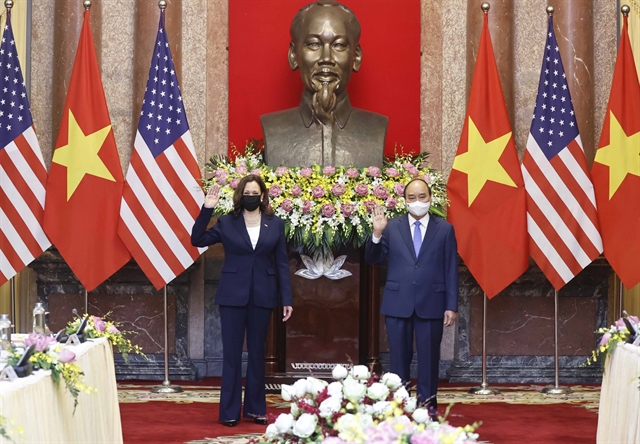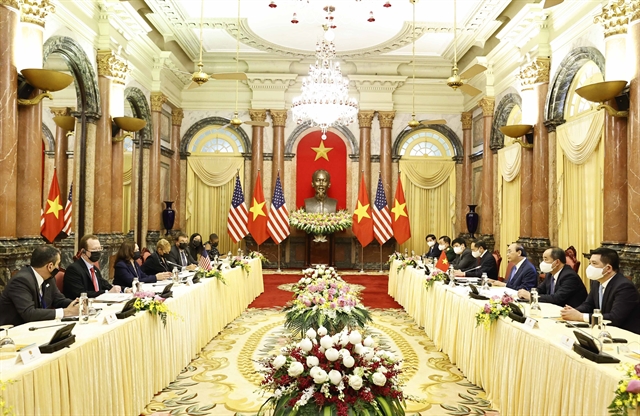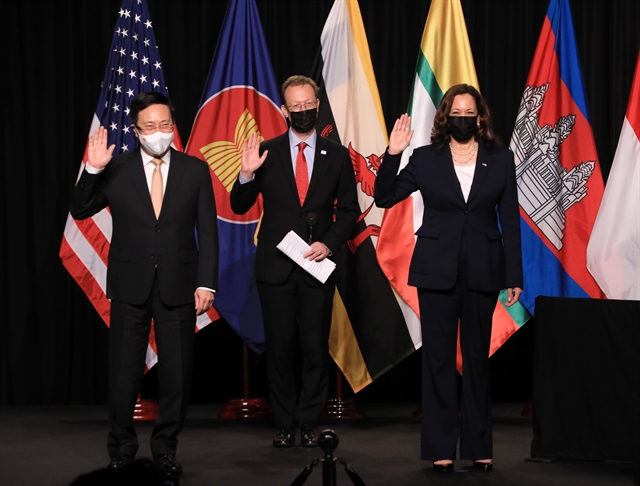
Deputy Prime Minister Phạm Bình Minh (left) and US Vice President Kamala Harris at the launch ceremony. — VNA/VNS Photo Lâm Khánh
HÀ NỘI — US Vice President Kamala Harris launched the US Center for Disease Control and Prevention Southeast Asia Regional Office in Hà Nội, at a ceremony on Wednesday during her three-day visit to the country.
The new Regional Office, based in Ngô Quyền Street in downtown area of Việt Nam's capital city, is one of the four in the world.
It will strengthen CDC’s ability to meet its mission of protecting Americans and people of the region by responding more rapidly to health threats wherever they occur and building key relationships to tackle shared health priorities.
Speaking at the ceremony, Vietnamese Deputy Prime Minister Phạm Bình Minh said: “Over the past 20 years, healthcare cooperation has been a highlight in the ties between the US and the region and this is also a key area of cooperation in the Việt Nam-US comprehensive partnership."
“Since the outbreak of COVID-19, Southeast Asian countries and the US have worked closely together to combat this pandemic, mitigate its consequences and foster economic recovery."
“We welcome the US decision to open this office in Hà Nội to show the development and vast potential of the Việt Nam-US comprehensive partnership. Việt Nam stands ready to facilitate the effective operation of this office.
“We are also convinced that the US’s CDC regional office in Hà Nội will work closely with partners within and outside the region in pursuit of the crucial goal of ensuring the best health care services for the people,” he said.
US Vice President Kamala Harris said: “It is one of four such offices in the entire world, and a true testament for our commitment to this important region.
“In this new era, our world is interconnected and interdependent. Partnership is therefore essential. We must all be willing to take on the challenges together. Let's take them on together to create opportunities together. That is why we launch this CDC office and our work together is so very important.”
The US has pledged US$500,000 to the ASEAN COVID-19 Response Fund to support the purchase of more vaccines and provided more than US$150 million in emergency assistance to the region, she said.
“With the launch of this office, we intend to build on these efforts and help to grow the public health infrastructure across Southeast Asia,” the Vice President said.
“We are working to train health professionals in the field of epidemiology. And that training programme has actually been in place in Asia since 1980.
“We are also investing in research and supporting the creation of emergency management systems. And we are working with all of you to develop the next generation of healthcare professionals.”
The Southeast Asia regional office is led by a Regional Director who is the most senior CDC official in the region and serves as the CDC Director’s representative, responsible for ensuring a coordinated and cohesive approach to the agency’s global health strategy.
An initial priority for the Southeast Asia regional office is the coordination of COVID-19 activities across the region, with support from Coronavirus Aid, Relief, and Economic Security (CARES) Act funding.
Priority areas of focus also include expanding regional public health laboratory training, developing innovative programmes to improve health for mobile and migrant populations, and expanding the reach of One Health (animal health) operations in and across countries in the region.
It also prioritises working towards the elimination of diseases such as measles, rabies, and malaria, and supporting US Government foreign policy initiatives in the region including the Indo-Pacific Strategy, US ASEAN Health Future, and the Lower Mekong Initiative.
Southeast Asia comprises of 11 countries and is home to over 687 million people and has a long history of working on health security issues because of significant experiences with emerging infectious diseases. — VNS
US pledges additional 1 million Pfizer vaccine doses to Việt Nam
Update: August, 25/2021 -
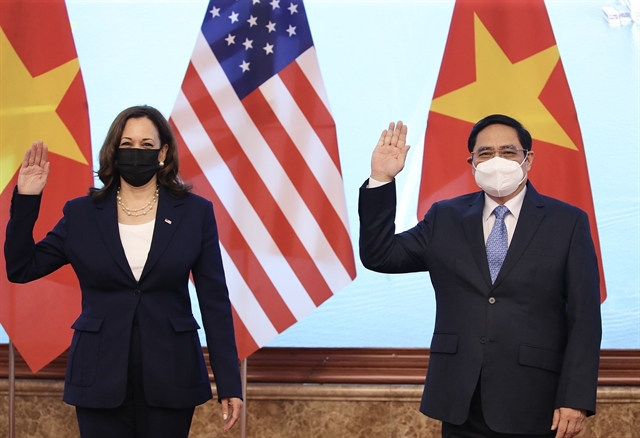
Vietnamese Prime Minister Phạm Minh Chính (right) yesterday held talks with US Vice President Kamala Harris during her three-day visit to Việt Nam. — VNA/VNS Photo Dương Giang
HÀ NỘI — The US will donate an additional one million doses of the Pfizer vaccine to Việt Nam, said US Vice President Kamala Harris during talks with Vietnamese Prime Minister Phạm Minh Chính on Wednesday.
The vaccines will start arriving within the next 24 hours.
With the additional donation, the total vaccines given by the US has reached 6 million doses.
Harris also committed an additional US$23 million in technical assistance and programmatic support to assist Việt Nam’s efforts to fight the pandemic, bringing the total assistance provided since the start of the pandemic to nearly $44 million.
This assistance will accelerate equitable access to and delivery of safe and effective COVID-19 vaccines, strengthen Việt Nam’s health system to respond to COVID-19, and build capacity to detect and monitor COVID-19 and future disease threats. USAID also provided the Vietnam Red Cross $1 million to reduce the impacts and prevent the spread of COVID-19 in vulnerable communities, according to the White House.
Vice President Harris highly appreciated the efforts of the Vietnamese Government in controlling and responding to the COVID-19 pandemic, affirming that the United States will continue to provide substantive support for Việt Nam to effectively respond to the pandemic and disease risks, maintaining the global supply chain without disruption.
Welcoming the US Vice President to Việt Nam, PM Chính said the visit is more significant against the grim backdrop of the COVID-19 pandemic in the world, as well as in Southeast Asia and in Việt Nam.
He affirmed Việt Nam perseveres with the foreign policy of independence, self-reliance, multilateralisation, and diversification of international relations to be a good friend, a reliable partner and a responsible partner of the international community.
“Việt Nam attaches great importance to the relations with the US, one of our most important partners. Việt Nam wishes to continue developing the Comprehensive Partnership and add substance, effectiveness with a long-term view towards stability to this relationship on the basis of respecting each other's independence, sovereignty, territorial integrity, and political system in the interest of mutual benefit,” he said.
Chính thanked US President Joe Biden, US Vice President Harris and the US people for donating such a vast quantity of vaccines and medical hardware to Việt Nam in the ongoing fight against COVID-19.
The US support is extremely timely and invaluable as the pandemic is developing in complex ways in the south of Việt Nam, including HCM City, he said.
US Vice President Kamala Harris expressed her pleasure to visit Việt Nam for the first time and emphasised that the US attaches importance to the Comprehensive Partnership with Việt Nam on the basis of respect for independence, sovereignty, territorial integrity and each other's political institutions.
She reaffirmed that the US will support a strong, independent, and prosperous Việt Nam and is committed to continuing to promote deeper, more stable and solid relations in the future.
PM Chính emphasised that Việt Nam considers economy and trade as a pillar and driving force of Việt Nam - US relations.
He proposed the two sides continue to strengthen co-operation within the framework of the Việt Nam-US Trade and Investment Framework Agreement (TIFA), and at the same time consider the possibility of establishing a new economic and trade co-operation framework to promote harmonious and sustainable trade cooperation.
“The Vietnamese Government is always ready to create all favourable conditions for US companies to do business in Việt Nam and wants the US to facilitate Vietnamese businesses to invest in the US.”
The Prime Minister highly appreciated the support and long-term commitment of the US to help Việt Nam overcome the consequences of the war in Việt Nam, including Agent Orange/dioxin decontamination projects, which had long-term effects on many Vietnamese families.
The Vietnamese Prime Minister proposed the US side increase the provision of scholarships to Vietnamese students and continue to promote co-operation in science - high technology, focusing on the medical and health sciences, especially the pharmaceutical industry, agricultural biotechnology, post-harvest technology, space innovation and co-operation for civil purposes.
US Vice President Kamala Harris said Việt Nam is one of the US' top 10 trading partners. That is a big area of focus for US in Southeast Asia and, in particular, in Việt Nam.
Harris affirmed that the relationship between the two countries in economy and security is being strengthened.
She emphasised that the US Government will continue to prioritise promoting co-operation with Việt Nam in economy - trade, climate change, science - technology, cooperation in civil space, and health.
She said the US will continue to support Việt Nam in overcoming war consequences, strengthening Việt Nam-US co-operation in United Nations peacekeeping activities, and enhancing the capacity of maritime security as well as development co-operation.
While exchanging views on international and regional situations, the two leaders affirmed ASEAN's central role in the East Sea, Mekong and Myanmar issues, and emphasised the principle of respecting international laws in handling regional issues.
“Our two countries share a common vision for the future of a free and open Indo-Pacific region.
“We are grateful for Việt Nam's constructive leadership in upholding freedom of the seas. And we will continue to work with you to push back against threats to the rule-based international order,” Harris said.
Regarding climate change issues, PM Chính said that this is a global issue, so a global approach is needed.
Việt Nam is determined and strongly committed to responding to climate change, developing a sustainable and green economy, and gradually reducing carbon emissions in line with the country’s development conditions. — VNS

Prime Minister Phạm Minh Chính welcomes US Vice President Kamala Harris. — VNA/VNS Photo Dương Giang
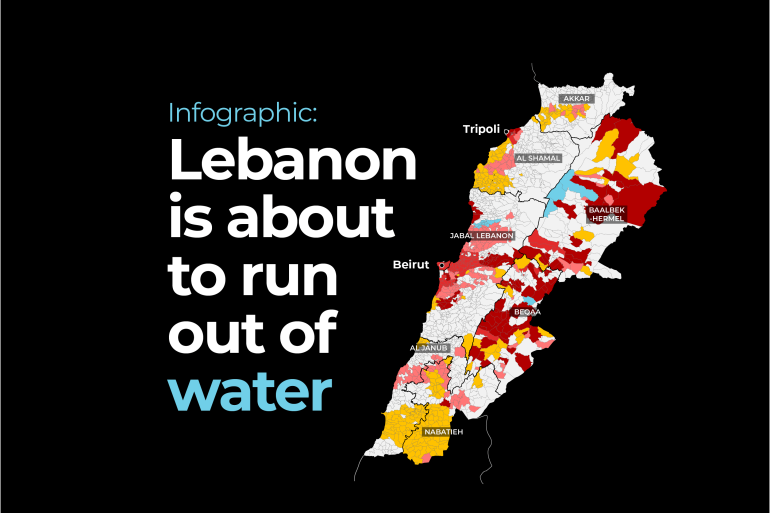
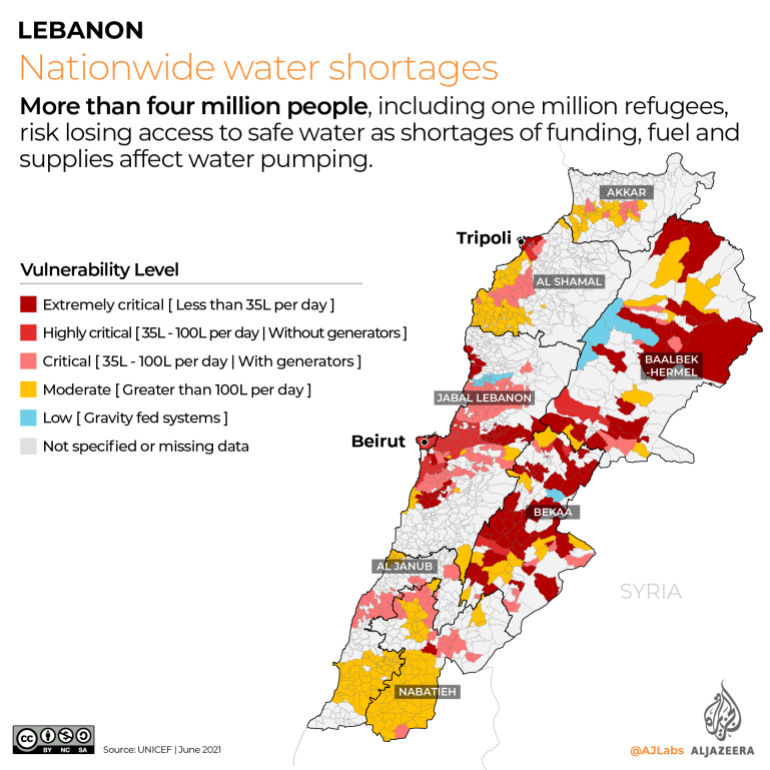
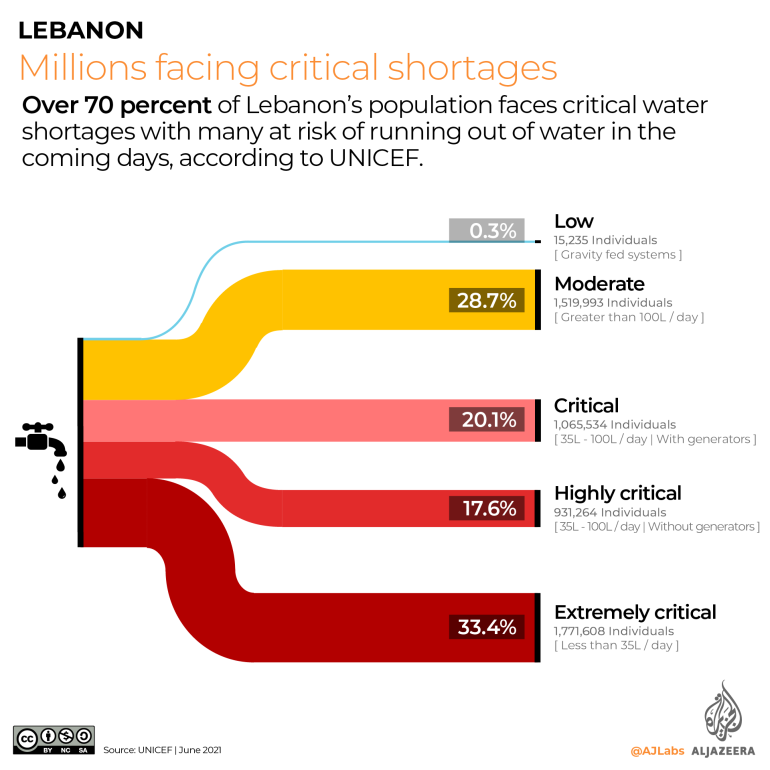 (Al Jazeera)
(Al Jazeera)